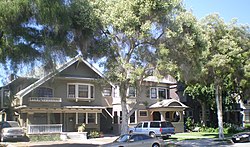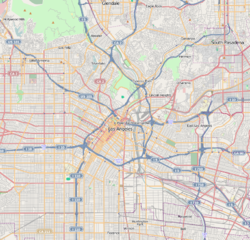Twentieth Street Historic District
Appearance
This article lacks inline citations besides NRIS, a database which provides minimal and sometimes ambiguous information. (November 2013) |
Twentieth Street Historic District | |
 Homes in the 20th Street Historic District | |
| Location | 912--950 20th St. (even numbers), Los Angeles, California |
|---|---|
| Coordinates | 34°2′9″N 118°16′44″W / 34.03583°N 118.27889°W |
| Architect | Watts, W. Wayman |
| Architectural style | Bungalow/Craftsman |
| NRHP reference No. | 91000915[1] |
| Added to NRHP | July 22, 1991 |
The Twentieth Street Historic District in Los Angeles, California consists of a row of Bungalow and Craftsman style houses in the 900 block on the south side of 20th Street. It is located in the West Adams neighborhood.

The homes were designed by W.Wayman Watts and built in the early part of the 20th Century. The district was added to the National Register of Historic Places in 1991.
See also
References
Further reading
- [1] Diane Wedner, "Neighborly Advice: Western Heights: Taking Over From Titans," Los Angeles Times, September 16, 2007, page K-4
- [2] Carol Mithers, "Vanishing: The History of One House in Los Angeles," Los Angeles Times Magazine, April 17, 2005, page 16
- [3] Scott Harris, "Days Are Numbered for Historic Mansion That Sparked Racial Politics," Los Angeles Times, April 11, 1991, page VYB-1
- [4] Sandy Banks, "The 'Battle' of West Adams: Restorationists Buying Homes in Largely Black L.A. Neighborhood and Hostility to Them Has Risen," Los Angeles Times, December 1, 1985, page 1

